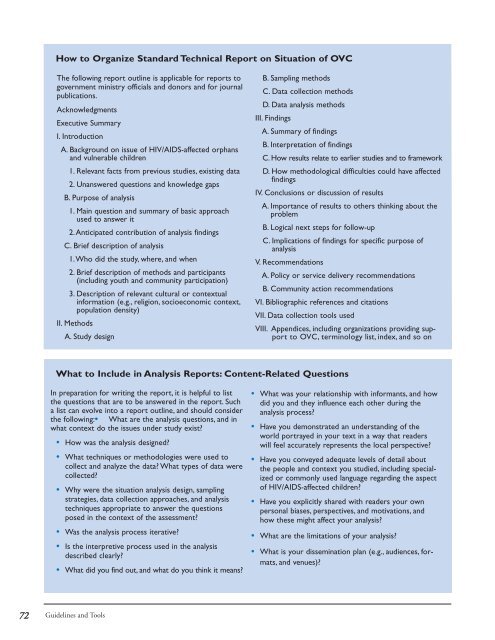Conducting a Participatory Situation Analysis of.pdf - Global HIV ...
Conducting a Participatory Situation Analysis of.pdf - Global HIV ...
Conducting a Participatory Situation Analysis of.pdf - Global HIV ...
You also want an ePaper? Increase the reach of your titles
YUMPU automatically turns print PDFs into web optimized ePapers that Google loves.
How to Organize Standard Technical Report on <strong>Situation</strong> <strong>of</strong> OVC<br />
The following report outline is applicable for reports to<br />
government ministry <strong>of</strong>ficials and donors and for journal<br />
publications.<br />
Acknowledgments<br />
Executive Summary<br />
I. Introduction<br />
A. Background on issue <strong>of</strong> <strong>HIV</strong>/AIDS-affected orphans<br />
and vulnerable children<br />
1. Relevant facts from previous studies, existing data<br />
2. Unanswered questions and knowledge gaps<br />
B. Purpose <strong>of</strong> analysis<br />
1. Main question and summary <strong>of</strong> basic approach<br />
used to answer it<br />
2.Anticipated contribution <strong>of</strong> analysis findings<br />
C. Brief description <strong>of</strong> analysis<br />
1.Who did the study, where, and when<br />
2. Brief description <strong>of</strong> methods and participants<br />
(including youth and community participation)<br />
3. Description <strong>of</strong> relevant cultural or contextual<br />
information (e.g., religion, socioeconomic context,<br />
population density)<br />
II. Methods<br />
A. Study design<br />
B. Sampling methods<br />
C. Data collection methods<br />
D. Data analysis methods<br />
III. Findings<br />
A. Summary <strong>of</strong> findings<br />
B. Interpretation <strong>of</strong> findings<br />
C. How results relate to earlier studies and to framework<br />
D. How methodological difficulties could have affected<br />
findings<br />
IV. Conclusions or discussion <strong>of</strong> results<br />
A. Importance <strong>of</strong> results to others thinking about the<br />
problem<br />
B. Logical next steps for follow-up<br />
C. Implications <strong>of</strong> findings for specific purpose <strong>of</strong><br />
analysis<br />
V. Recommendations<br />
A. Policy or service delivery recommendations<br />
B. Community action recommendations<br />
VI. Bibliographic references and citations<br />
VII. Data collection tools used<br />
VIII. Appendices, including organizations providing support<br />
to OVC, terminology list, index, and so on<br />
What to Include in <strong>Analysis</strong> Reports: Content-Related Questions<br />
In preparation for writing the report, it is helpful to list<br />
the questions that are to be answered in the report. Such<br />
a list can evolve into a report outline, and should consider<br />
the following:• What are the analysis questions, and in<br />
what context do the issues under study exist?<br />
• How was the analysis designed?<br />
• What techniques or methodologies were used to<br />
collect and analyze the data? What types <strong>of</strong> data were<br />
collected?<br />
• Why were the situation analysis design, sampling<br />
strategies, data collection approaches, and analysis<br />
techniques appropriate to answer the questions<br />
posed in the context <strong>of</strong> the assessment?<br />
• Was the analysis process iterative?<br />
• Is the interpretive process used in the analysis<br />
described clearly?<br />
• What did you find out, and what do you think it means?<br />
• What was your relationship with informants, and how<br />
did you and they influence each other during the<br />
analysis process?<br />
• Have you demonstrated an understanding <strong>of</strong> the<br />
world portrayed in your text in a way that readers<br />
will feel accurately represents the local perspective?<br />
• Have you conveyed adequate levels <strong>of</strong> detail about<br />
the people and context you studied, including specialized<br />
or commonly used language regarding the aspect<br />
<strong>of</strong> <strong>HIV</strong>/AIDS-affected children?<br />
• Have you explicitly shared with readers your own<br />
personal biases, perspectives, and motivations, and<br />
how these might affect your analysis?<br />
• What are the limitations <strong>of</strong> your analysis?<br />
• What is your dissemination plan (e.g., audiences, formats,<br />
and venues)?<br />
72<br />
Guidelines and Tools















